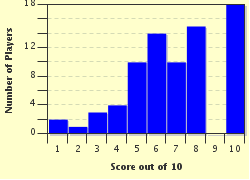
Ballroom Blitz Trivia Quiz
Modern ballroom dancing has made its way into people's homes through a succession of TV competitions. This quiz is about matching a selection of ballroom dances to their country of origin. See how you go.
A matching quiz
by suomy.
Estimated time: 4 mins.
- Home
- »
- Quizzes
- »
- Humanities Trivia
- »
- Performing Arts
- »
- Dance
